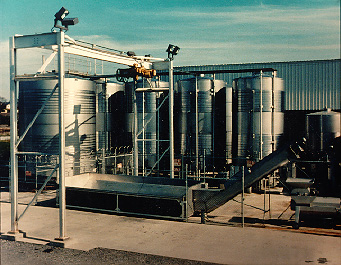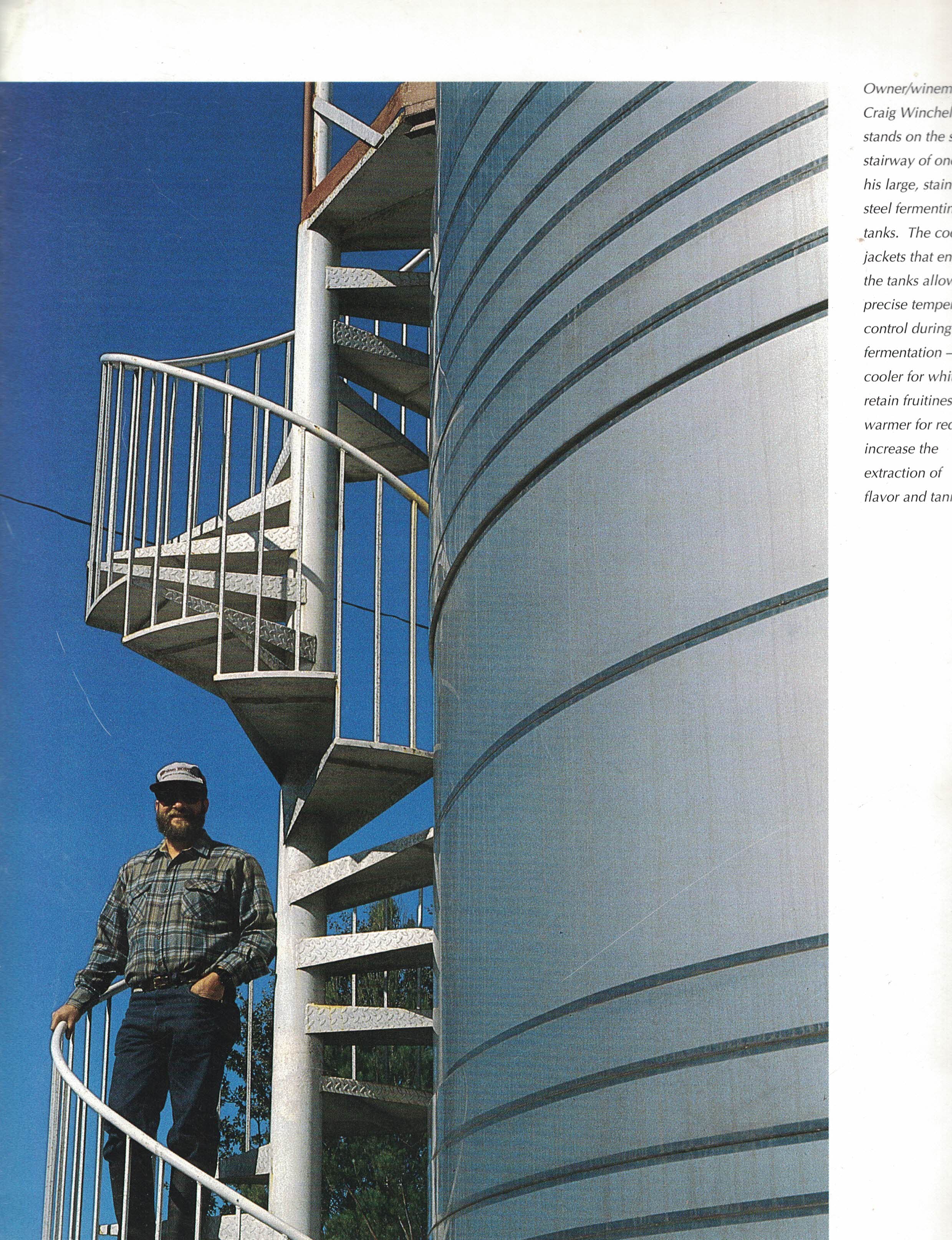GAN EDEN- The First Iteration

The
first iteration of GAN EDEN took place from 1985 to 2005, in
our own facility,which we constructed ourselves on our own 20
acres. It was a larger facility than what I am proposing now
in Lolonis. It consisted of 2-10,000 sq. ft. buildings (32
feet tall to accommodate tanks), a 2500 sq. ft. shed, a large
tank pad and crush area, along with sedimentation and aeration
ponds for winery waste water. It had a use permit for 40,000
cases, but was large enough to modify the use permit to allow
100,000 cases/year. Also on the property were my home and a 1
acre pond off the front porch. 17 acres of apple trees
were leased to a grower.
GAN EDEN was a fully equipped winery. It had a 5 ton overhead hoist, and could accept grapes in most common delivery systems of the day, from 5 ton gondolas to 2 ton valley tanks. It could not accept deliveries in smaller containers. GAN EDEN was designed for efficiency. One person could handle the entire crush, and 2 people made it an easy day. It had a crusher-stemmer and press which would allow about 45 tons of white grapes to be processed per day, though normally we crushed no more than 30 tons, and it could certainly have crushed 100 tons of red grapes into tanks in any day, though the maximum I crushed in a day was 75 tons. Its largest tanks held 20,000 gallons. In contrast, the Lolonis facility was designed only to accept half-ton picking bins and smaller lug boxes. It does not have the robust equipment of GAN EDEN's previous iteration, and is not designed to minimize personnel requirements. However, it is available, relatively inexpensive, and has enough equipment to make it worthwhile.
GAN EDEN was initiated at a time when the paradigm for wine sales was the 3-tier system of distributor/retailer/consumer. We had a small sales force to sell direct to retailers in California, but outside of the state, we relied entirely on distributors. Sometimes, they would do a good job of actually selling our wine, but often, they were little more than warehouses and order takers, making off like bandits with 25% gross margin on sales.
It
was well known at the time that a tasting room offered certain
advantages, among them being attracting consumers and having a
means of selling directly to them at full mark-up, for twice
as much money as would normally be realized selling through
distributors. For those located where the action was,
where the consumers were abundant, this made it worthwhile to
staff the tasting room on a continuous basis. For those
outside those areas, it at least afforded the opportunity to
deal direct with consumers on a more casual basis, if they
would show up to the winery. However, neighbors often
complained of traffic and noise from tasting rooms, and it
became more difficult to become permitted for one. GAN
EDEN was located near the prime consumer area, but still did
not have a tasting room with which to gain access to those
consumers. We were allowed to deal with consumers by
invitation only. In practice, this meant that if someone
called ahead of time, we would invite them to the winery if I had the time to entertain, give
tours and sell wine. We were allowed to sell and ship
wine direct to consumers in California, but elsewhere, the
only direct contact we had was if they were "invited" to the
winery.
Late in the life of GAN EDEN, there was a paradigm shift. A series of lawsuits resulted in the legalization of direct-to-consumer-sales outside of the state of California. This presented many potential opportunities. We began our web site in earnest in order to achieve an on-line relationship with consumers, and we dissolved our relationships with distributors to whom we seemed unimportant, in order that we could sell direct to consumers. Although some states have balked at direct sales across state lines, I believe it is pretty much here to stay. States, though, wish to gain tax revenue from excise taxes, which they have lost due to losing control over distribution within their states. Some have legislated that wineries selling into the state must keep records, pay excise taxes, and potentially be audited by those states. Others have designated that wine must be shipped to a designated retailer within the state, and those retailers would be responsible for tax collection. They have made it difficult for UPS and FedEx to operate at all in such states unless they sign agreements refusing to transport wine unless the state's requirements are met. Eventually, this will all get sorted out in a way that is acceptable to all parties involved. What it has done is simply perpetuate the 3-tier system. Our plans for the new GAN EDEN iteration are to maximize direct sales to consumers. It is a paradigm that makes great business sense. Costs of customer acquisition have decreased a great deal, as the internet has begun dominating every aspect of our society.
Gan Eden's wines won a considerable number of medals and considerable fame in the 20 years of its existence as a wine producer, and have continued their success even to the present time. A recently discovered cache of GAN EDEN 1990 Cabernet Sauvignon contained enough wine to warrant the one who discovered it to submit it into the 2017 New York International Wine Competition, and won a Silver medal 27 years after it was harvested. Later, it was submitted to Wine Enthusiast Magazine's tasting panel, where in the December issue, it was awarded a score of 88 points-- not bad for a 27 year old wine. While I attribute its condition to the storage conditions in the cave where it was discovered, there is no doubt that the wine originated with quality. All told, several score articles have been written about GAN EDEN, and many hundreds of medals have been won.


Craig Winchell, Tel: (707) 494-7095 Email: ganedenwines@gmail.com
LINKS
GAN EDEN Home
Proposal
-
Introduction to The Wine Industry
-
Business Assumptions
-
Projected Cash Flows at $150/case-Spreadsheet
-
Projected Cash Flows at $200/case- Spreadsheet
-
Projected Cash Flows at $300/case- Spreadsheet
-
A little about Lolonis Winery
-
GAN EDEN- The Old Label, 1985-2005
-
Sample 1 of GAN EDEN's new label
-
Sample 2 of GAN EDEN's new label